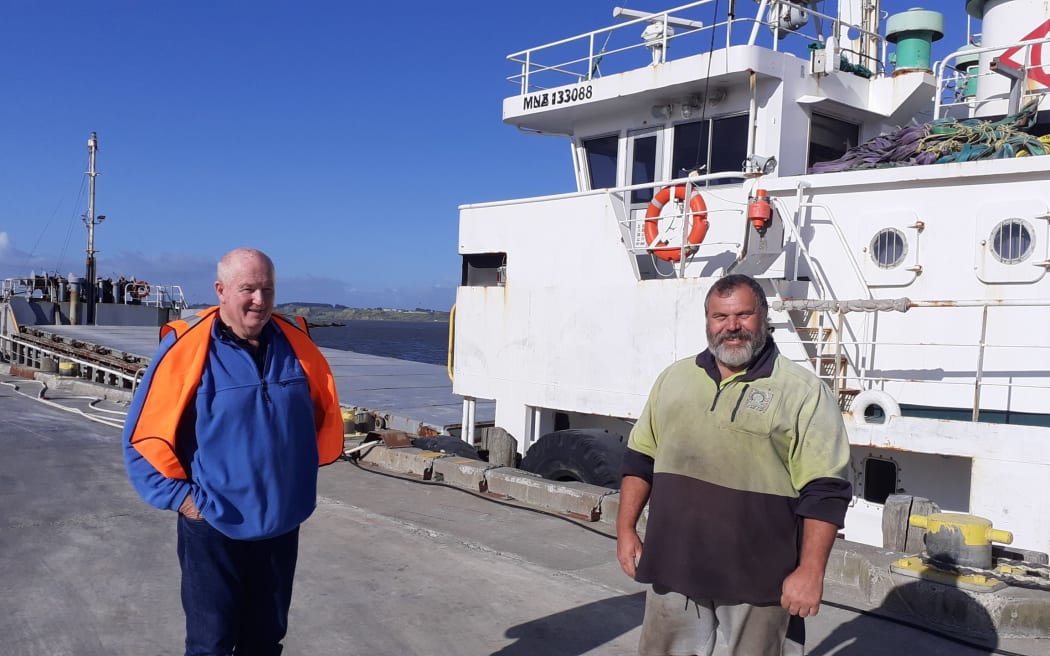Cargo volume through Whanganui set to triple with coastal shipping boost
The amount of cargo being shipped through Whanganui is set to triple with new investment to boost coastal shipping around the country.
Coastal Bulk Shipping general manager Doug Smith (left) and Whanganui Port worker Greg Robinson at Wharf No. 1.
Photo: LDR / Moana Ellis
The government has announced $30 million for coastal shipping through the National Land Transport Programme to improve domestic shipping services, reduce emissions, improve efficiency and upgrade maritime infrastructure.
Transport Minister Michael Wood said the funding is a step toward a more sustainable and competitive coastal shipping sector.

Four suppliers have been selected to deliver expanded coastal shipping services. They are: Coastal Bulk Shipping, Move International, Swire Shipping and Westland Mineral Sands Co.
Whanganui-based Coastal Bulk Shipping will use the funding to buy a second, bigger ship to boost the amount of cargo moving through Whanganui from an average 20,000-25,000 tonnes annually to 75,000 tonnes.
Coastal Bulk Shipping general manager Doug Smith said its 800-tonne freighter MV Anatoki ships mainly between Whanganui, Gisborne, Nelson and Timaru and is the only commercial vessel servicing the Port of Whanganui.
The company will buy a second ship that is bigger but still able to service the Whanganui Port.
“It will need to work within the constraints of the Whanganui Port, be manoeuvrable and of reasonably shallow draught – but considerably bigger than the Anatoki,” Smith said.
“This will open up Whanganui and the North Island to the South Island market and vice versa.”
The 50-metre Anatoki docks in Whanganui up to three times a week, unloading grain from the South Island for malting in Marton, salt from the south for tanneries, and timber and dolomite, which are trucked into the central regions. Return journeys shift cargo such as plastic pipe from local producers to Nelson and posts and poles to the South Island.
“It is busy,” Smith said. “We brought in a load of dolomite on Friday that was trucked through to Marton, there’s 600 cubic metres of timber on the wharf waiting to be trucked away now, and she’s due to take pipes to Nelson and then a load of trailers from Gisborne to Timaru when the weather clears.
“The Anatoki has only 800 tonne capacity but will cart close to 38,000 tonnes this year,” Smith said.
The new 70-metre ship will be able to carry much more, including up to 80 containers, opening up opportunity to ship further afield around New Zealand’s coastline.
“It is exciting. It’s great for Whanganui. At one stage, Whanganui was one of the top three or four ports in New Zealand. Coastal shipping can be built up again but we will need to rebuild infrastructure.”
The transport minister said coastal shipping was a small but important part of the New Zealand freight system and would help New Zealand achieve its decarbonisation goals.
“The government is investing in making coastal shipping a more viable alternative to strengthen and diversify our domestic supply chain, helping to secure New Zealand’s recovery from COVID-19,” Wood said.
“With the freight industry’s support, these additional services will help to resolve immediate challenges to the coastal shipping and the wider freight sector, address some of the current issues facing the international and domestic supply chains and provide a platform for future growth across all modes with increases in capacity and capability for both new and existing bulk materials and containerised cargo.”
Each of the four selected suppliers would bring at least one additional coastal shipping vessel into service, and this would improve the resilience of the overall freight supply chain, he said.
“The four preferred suppliers will invest over $60 million through their proposals, resulting in combined investment in the sector of over $90 million,” Wood said.
“When the new services are fully operational, it is estimated they will remove around 35 million kilometres of truck travel from New Zealand’s roading network every year, reducing wear and tear and improving safety for road users, while at the same time creating new employment opportunities for mariners and supporting regional development.
“This will also support our commitment in the recently released Emissions Reduction Plan to reduce emissions from freight transport by 35 per cent by 2035.”
Local Democracy Reporting is Public Interest Journalism funded through NZ On Air


